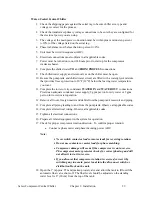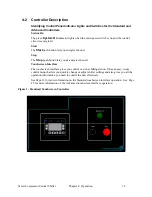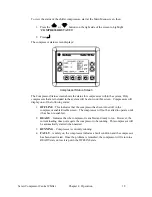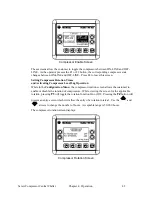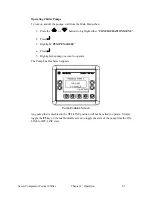
Screw Compressor Central Chiller
Chapter 3: Installation
30
19.
Close the discharge butterfly valve then crack it open; open all pump suction
butterfly valves fully, then start the pump and observe the gauge.
20.
Check for proper pump rotation direction. To confirm proper rotation:
a.
Observe a pump pressure gauge connected to the suction and discharge sides
of the pump casing through two
¼
” (approx. 6.4 mm) gauge cocks.
b.
Close the gauge cock leading to the pump suction and open the gauge cock
leading to the pump discharge.
c.
Close the discharge butterfly valve, crack it open, then start the pump and
observe the gauge.
1.
If the gauge indicates within 15 psi (103.4 kPa/1.03 bars) below
the pump curve, pump rotation is correct.
Pump rotation is
clockwise opposite the shaft end
.
2.
If the gauge indicates 20 psi (137.9 kPa/1.38 bars) or more
below the pump curve, the pump is running backwards. Reverse
rotation by interchanging any two power mains to the pump
starter.
3.
Recheck the pressure to be sure it increased.
21.
Check the water level in the pump tank to be sure the pump does not run dry while
the system piping is being filled.
22.
Once the system is full, open the pump discharge butterfly valve fully.
23.
Check your work and proceed to the Startup procedure.
Remote Air-Cooled Central Chiller Startup Checklist
1.
Check the shipping papers against the serial tag to be sure chiller size, type and
voltage is correct for the process.
2.
Check the transformer primary voltage connections to be sure they are configured for
the electrical power you are using.
3.
The voltage at the main power connection must read within plus or minus ten percent
(±10%) of the voltage listed on the serial tag.
4.
Phase imbalance must be less than two percent (<2%).
5.
Unit must be wired in sequence (ABC).
6.
Electrical connections must conform to all applicable codes.
7.
Tighten all electrical connections.
8.
Complete the chilled water
TO
and
FROM PROCESS
connections.
9.
The optional or field installed chilled water supply and return valves must be open.
10.
The power needs to be on 24 hours prior to starting the unit for the crankcase heater.
11.
Be sure the tank and chilled water circuit piping are filled with a water/glycol
mixture. The water/glycol mix should provide freeze protection to 20°F below the
leaving water temperature you’ve selected.
12.
The air cooled condenser should have an adequate supply of air for proper operation.














